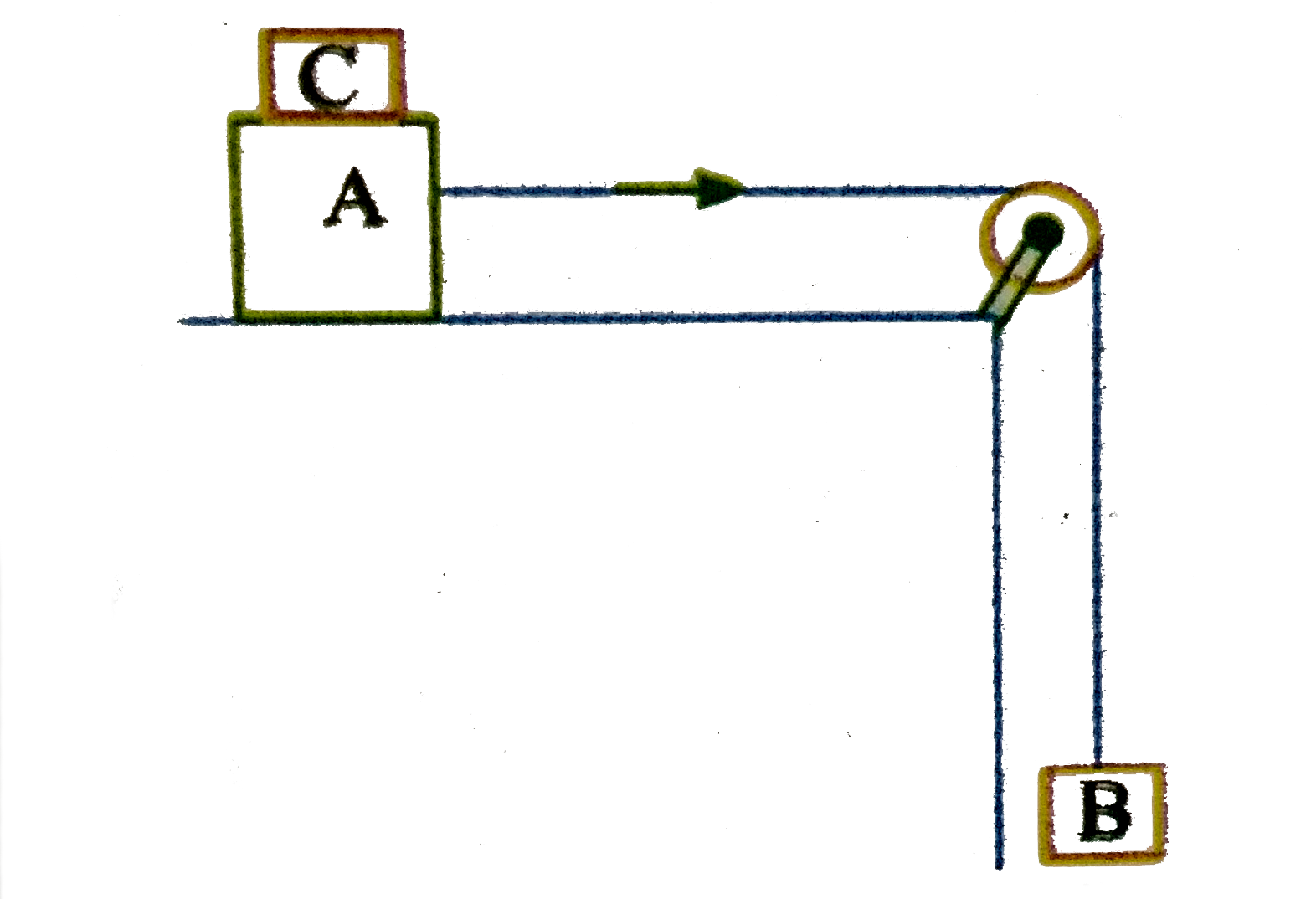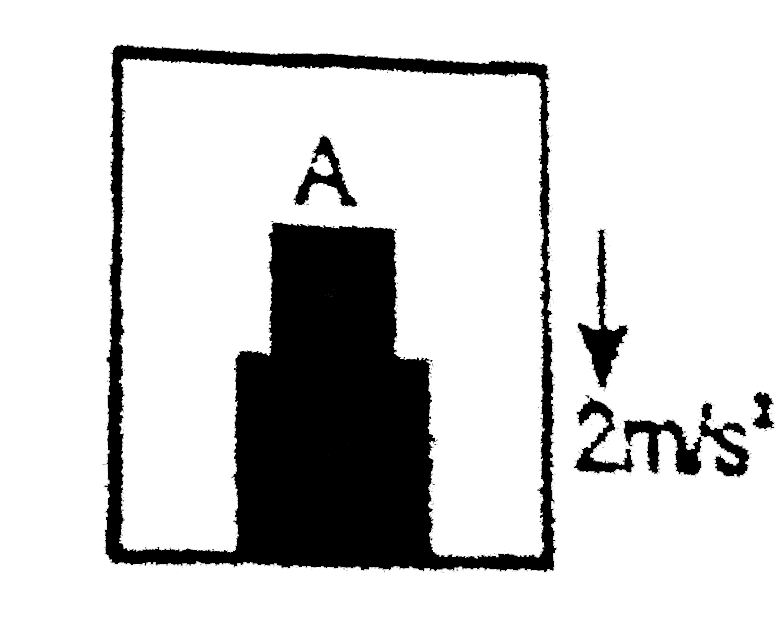(i) Four small blocks are interconnected with light strings and placed over a fixed sphere as shown. Blocks A, B and C are identical each having mass m = 1 kg. Block D has a mass of m´ = 2 kg. The coefficient of friction between the blocks and the sphere is μ=0.5. The system is released from the position shown in figure.

(a) Find the tension in each string. Which string has largest tension?
(b) Find the friction force acting on each block.
[Take tan37∘=34,g=10m/s2]
(ii) A fixed square prism ABCD has its axis horizontal and perpendicular to the plane of the figure. The face AB makes 45∘ with the vertical. On the upper faces AB and BC of the prism there are light bodies P and Q respectively. The two bodies (P and Q) are connected using a string S1 and strings S0 and S2 are hanging from P and Q respectively. All strings are mass less, and inextensible. StringS1 is horizontal and the other two strings are vertical. The coefficient of friction between the bodies and the prism is μ0 . Assume that P and Q always remain in contact with the prism.
(a) If tension in S0 is T0, find the minimum tension (T1) in S1 to keep the body P at rest.
(b) A mass M0 is tied to the lower end of string S0 and another mass m2 is tied to S2 . Find the minimum value of m2 so as to keep P and Q at rest.

The correct Answer is:(a) TBC=10N;TAB=12N;TAD=7N
(b) fC=0;fB=4N;fA=5N;fD=5N
(ii) (a) T1=(1−μ01+μ0)T0
(b) m2=(1−μ01+μ0)2M0
Step by step video, text & image solution for (i) Four small blocks are interconnected with light strings and placed over a fixed sphere as shown. Blocks A, B and C are identical each having mass m = 1 kg. Block D has a mass of m´ = 2 kg. The coefficient of friction between the blocks and the sphere is mu = 0.5. The system is released from the position shown in figure. (a) Find the tension in each string. Which string has largest tension? (b) Find the friction force acting on each block. [Take "tan"37^(@) = (3)/(4) , g = 10 m//s^(2)] (ii) A fixed square prism ABCD has its axis horizontal and perpendicular to the plane of the figure. The face AB makes 45^(@) with the vertical. On the upper faces AB and BC of the prism there are light bodies P and Q respectively. The two bodies (P and Q) are connected using a string S_(1) and strings S_(0) and S_(2) are hanging from P and Q respectively. All strings are mass less, and inextensible. String S_(1) is horizontal and the other two strings are vertical. The coefficient of friction between the bodies and the prism is mu_(0) . Assume that P and Q always remain in contact with the prism. (a) If tension in S_(0) is T_(0), find the minimum tension (T_(1)) in S_(1) to keep the body P at rest. (b) A mass M_(0) is tied to the lower end of string S_(0) and another mass m_(2) is tied to S_(2) . Find the minimum value of m2 so as to keep P and Q at rest. by Physics experts to help you in doubts & scoring excellent marks in Class 11 exams.
Updated on:21/07/2023Topper's Solved these Questions
Similar Questions
A particle is acted upon by a force for 1 second whose X component remains constant at Fx=30N but y and z components vary with time as shown in the graph. Calculate the magnitude of change in momentum of the particle in 1 s. What angle does the change in momentum (Δ→P) make with X axis ?

View SolutionThe pulley of radius R can rotate freely about its axle as shown in the figure. A thread is tightly wrapped around the pulley and its free end carries a block of mass m. When the block is at a height h above the ground the system is released (i.e., the pulley is made free to rotate & the block is allowed to fall) and at the same instant the axle is moved up keeping it horizontal all the time. When the block hits the floor the axle has gone up by a distance 2h. Find the angle by which the pulley must have rotated by this time.

View SolutionFor the arrangement shown in the figure the coefficient of friction between the two blocks is mu . If both the blocks are identical and moving ,then the acceleration of each block is
View SolutionThere block A B ,and C of equal mass m are placed one over the other on a frictionless surface (table) as shown in figure The coefficient of friction between any blocks A ,B and C is μ The maximum value of mass of block D so that the blocks A,B and C move without slipping over each other is

View SolutionA block A of mass 3kg and another block B of mass 2kg are connected by a light inextensible string as shown in figure. If the coefficient of friction between the surface of the table and A is 0.5 What maximum mass C is to be placed on A so that the system is to be in equlibrium
 .
.
View SolutionTwo blocks A and B , each of mass 10 kg , are connected by a light string passing over a smooth pulley as shown in the figure. Block A will remain at rest if the friction on it is
View SolutionThe elevator shown in figure is descending, with an acceleration of 2m/s2. The mass of block A is 0.5 kg. the force exerted by block A on block B is (mass of block B is 1 kg)

View SolutionThree blocks A, B and C havig masses m kg, 2kg and 3 kg are attached by massless strings and ideal pulleys as shown in the figure. When the system is realeased from rest if the block A remains stationary. the mass of block A is
View SolutionConsider the shown arrangement. The coefficient of friction between the two blocks is 0.5 . There is no friction between the 4 kg block and of 12 N is applied on the 2 kg block as shown in the figure, the acceleration of the 4 kg block would be
View SolutionThe coefficient of friction between the block A of mass m & block B of mass 2m is μ. There is no friction between block B & the inclined plane. If the system of blocks A & B is released from rest & there is no slipping between A & B then :

View SolutionA block of mass 1 kg is placed on a wedge shown in figure. Find out minimum coefficient of friction between wedge and block to stop the block on it.

View SolutionA small block of mass 2 kg is placed on a bigger block of mass 4 kg which is attached to horizontal spring of spring constant K=500N/m as shown in figure, coefficient of friction between block is 0.2 .Maximum amplitude of system so that there is no relative slipping between blocks.

View SolutionTwo blocks A and B of respective masses 6 kg and 4 kg are connected with a string passing over a light friction less pulley as shown in the figure . The coefficient of friction between the block A and horizontal surface is 0.4 . Then the minimum mass of block C which should be placed over A to prevent it from moving is :

View Solution100 किग्रा द्रव्यमान का ब्लॉक A, 200 किग्रा द्रव्यमान के ब्लाक B पर रखा हुआ है तथा चित्र में दिखाए अनुसार एक दीवार से बंधा हुआ है। ब्लॉक A और B के बीच घर्षण गुणांक 0.2 तथा ब्लॉक B और जमीन के बीच घर्षण गुणांक 0.3 है। ब्लॉक B को गति देने के लिये न्यूनतम लगाया गया बल F होगा (g = 10 मी से−2)
View SolutionTwo blocks A and B having masses 100 kg and 200 kg are placed as shown in the figure. The block A is connected to a wall with a light inextensible string. The coefficient of friction between the blocks is 0.3 and that between the block B and the floor is 0.03. Then the minimum force required to move the block B will be (take g=10m//s^(2) )
View SolutionFor the arrangement shown in the figure the coefficient of friction between the two blocks is mu . If both the blocks are identical and moving ,then the acceleration of each block is
View Solution

